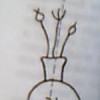The image of the snake
The image of the snake has been present in crafts since ancient times, first in stone, then in metal, and later on fabric.
Long time ago mankind discovered that certain life events are connected to celestial bodies and cycles of nature, such as season change, day and night, tides and different amount of sunlight.
People saw that many events are involved in cycles of 12 months or 12 years.
That is how the Zodiac started. We know that each year corresponds to a certain animal, and among these animals is the snake.
According to the oriental calendar, 2013 was the year of the snake. The next one will be 2025.
Astrologists think that a child born in the year of the Snake will be wise, prescient, strong-willed, meticulous, energetic, proud, and gentle.
A girl born in this year will be pretty. In Japan the best compliment for a girl is “beautiful as a snake”.
In ancient Egypt the image of the snake is very important. It is a part of the old religious tradition.
A legend exists that says the grave of Osiris was guarded by snakes.
People treated snakes as Osiris’s companions and prayed to them for good health and long life.
Worshipping of snakes and the bull was related to the image of one of the Egyptian sun gods, Aten. Perhaps that is why we often see the bull and the snake together.
Later people thought of the snake as a guardian of the dead, and many burial traditions included its image, which lead to many images of the snake in art.
In Tutankhamun’s grave they found a carnelian snake.
In Babylon the snake was both good and evil.
In Sumerian book of dreams it says that if you are holding a snake in your hand, your dreams will come true. If you see a snake in your dream, you will have a child.
In Mesopotamia the snake symbolized a good harvest.
If you dream of two snakes, you labor and delivery will go smoothly.
The goddess of wisdom and justice, Athena, born of Zeus and Metis, had a snake and an owl as her symbols.
Athena was the patron of snakes and many snakes lived in her temple.
The source of this tradition is in Aegean culture where goddesses were pictured as snakes.
The Greek also worshipped Erichthonius son of Gaia.
In India they still worship snakes as gods. In the Rigveda the snake is a symbol of fire.
One of the Trimurti, Vishnu, is depicted as lying on the Great Serpent Sheshnaag.
The Moon Snake, as well as horns and thorns, is a popular symbol of lunar religion. The fish and the snake are interchangeable.
In China the dragon is a symbol of a harvest-bringing rain and a holy spirit.
The Japanese worship serpents and other reptiles.
Snakes could also personify enemies and evil, that is why sometimes they symbolize the fight between good and evil.
For example, there is a legend of the Serpent-Peri. According to it, this fairy lived long time ago in the steppes and woods where no human went.
In the daylight she was a beautiful peri (fairy), and at night she turned into a snake.
In almost every mythology the snake is connected to earth, feminine fertility, water, and rain.
Snakes were supposed to guard souls of the dead from evil spirits. The mountain Tajiks believed in the great magician Shokhi Moro (Master of Snakes), who lived on top of a mountain and ruled over snakes and dragons.
That is why the tree and the snake often bore the same symbolic meaning. The people of Darvaz, Vanj, Yazgulyam, Rushon, and Shighnan (Tajikistan) used the image of the snake in art.
The snake can be seen on the walls of their buildings and on their pottery. These images were considered symbols of wealth.
Snakes as talismans appear in snakehead-shaped ornaments.
Ancient jewelers often used the image of the snake. They paid the most attention to beautiful snake eyes, believing in their magical powers.
We very often see snake images on bracelets. This was the idea of protecting the person wearing them from the evil eye. These bracelets can be found in old tombs.
Men and women would wear matching bracelets. In India bracelets were for married women.
In ancient Rome the most valuable were the bracelets that looked like a snake coiling around the wrist ending in snake head. They symbolized youth and energy.
It is possible that bracelets as ornaments for women started as male talismans protecting the owners from wounds.
Medieval bracelets with snake motifs were found during excavations in Sidzhak, Uzbekistan.
We can see snake images in other accessories and jewelry, such as belt buckles, rings, and lockets.
In the tomb of a Scythian queen they found gold earrings in the form of snakes coiling around Athena’s head.
Earrings and household items with the image of a serpent-tailed goddess were found in the Dnieper region, in Crimea, and along the Kuban. The Scythian goddess, also known as the Serpent-tailed Mother Goddess is known from the excavations in the lower Dnieper area.
So the image of the snake has been present throughout the human history. It can be found in all types of jewelry.
It is obvious that the snake does not always represent terror and fear. It is more important that the snake is a symbol of beauty and healing in art as a whole and in the art of jewelry specifically.



